From the coastal shores of Mombasa to the vast plains of the Masai Mara, Kenya has long and justly been labeled a wildlife paradise. Nature lovers, television producers, and photographers have flocked to the country in their millions for more than 100 years.
Apart from its amazing animal diversity, Kenya also hosts more than 1,000 bird species that are as diverse as they’re interesting and frequently spectacular. In this article, we’ll look at 10 of Kenya’s most exquisite birds and why they are ‘must-sees’ on every visitor’s bucket list.
So, whether you’re an ornithologist, an avid birder, or just someone with an appreciation of nature’s diverse wonders, let’s take flight with some of Kenya’s feathered marvels!
1. African Fish Eagle (Haliaeetus vocifer)
The iconic African fish eagle is a large raptor found throughout sub-Saharan Africa. Its clear and characteristic call has even been referred to as ‘the voice’ of Africa.
Often seen as a symbol of freedom and power, it’s the national bird of several African countries, including Malawi, Namibia, Zambia, and Zimbabwe. In Kenya, it’s found in aquatic habitats in the Masai Mara, Tsavo West National Park, and Lake Nakuru National Park.
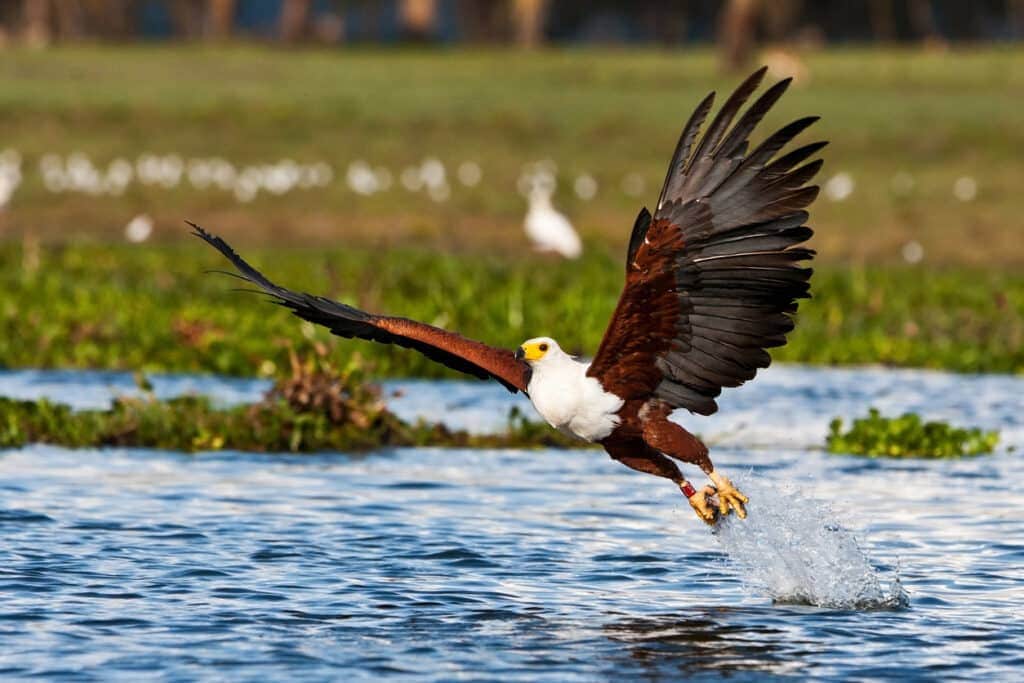
Fish eagles can weigh up to 3.6 kg/7,9 lbs, and the female is larger than the male. Their wingspans can reach 2.4 m or 8 ft. They like habitats near lakes, rivers, and coastal regions where they can fish which they do by snatching fish from the water with their powerful talons.
Fish is the main portion of their diet, though they have been known to prey on birds as well. They often steal prey from other birds which makes them kleptoparasites!
2. Lilac-Breasted Roller (Coracias caudatus)
The outrageously gorgeous lilac-breasted roller is Kenya’s national bird. They’re widely distributed throughout sub-Saharan Africa in generally stable populations. They thrive in habitats such as open woodlands and savannahs.
They’re renowned for their vibrant plumage of no fewer than eight colours, with bright lilac chests and turquoise wings. They also have a distinctive black mask around their eyes. Adult lilac-breasted rollers weigh around 110 grams, or just under four ounces.
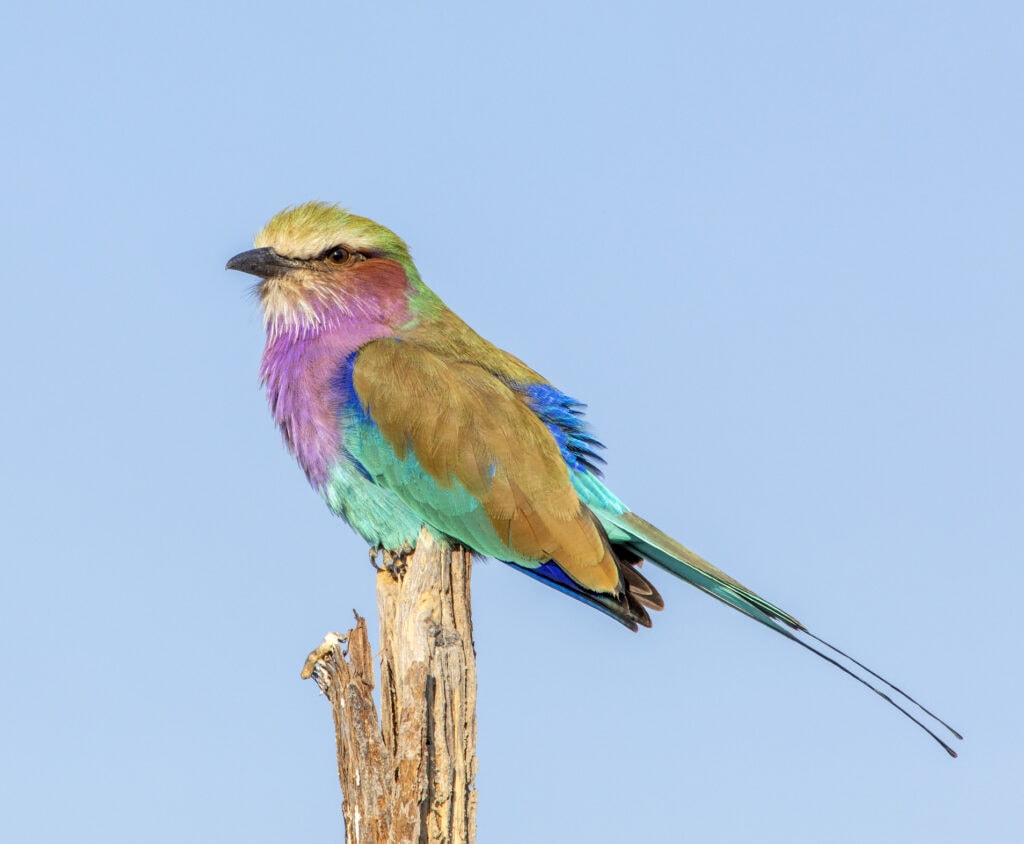
These rollers are energetic birds and agile flyers, and are often seen perched on branches. They then swoop down for their prey which includes insects like grasshoppers, beetles and the occasional lizard, crab, rodent or amphibian.
3. Superb Starling (Lamprotornis superbus)
The African superb starling is characterised by its striking and colourful plumage, featuring iridescent blue and green feathers on its head, wings, and back. Its chest is a rich glossy chestnut brown and its underparts are white.
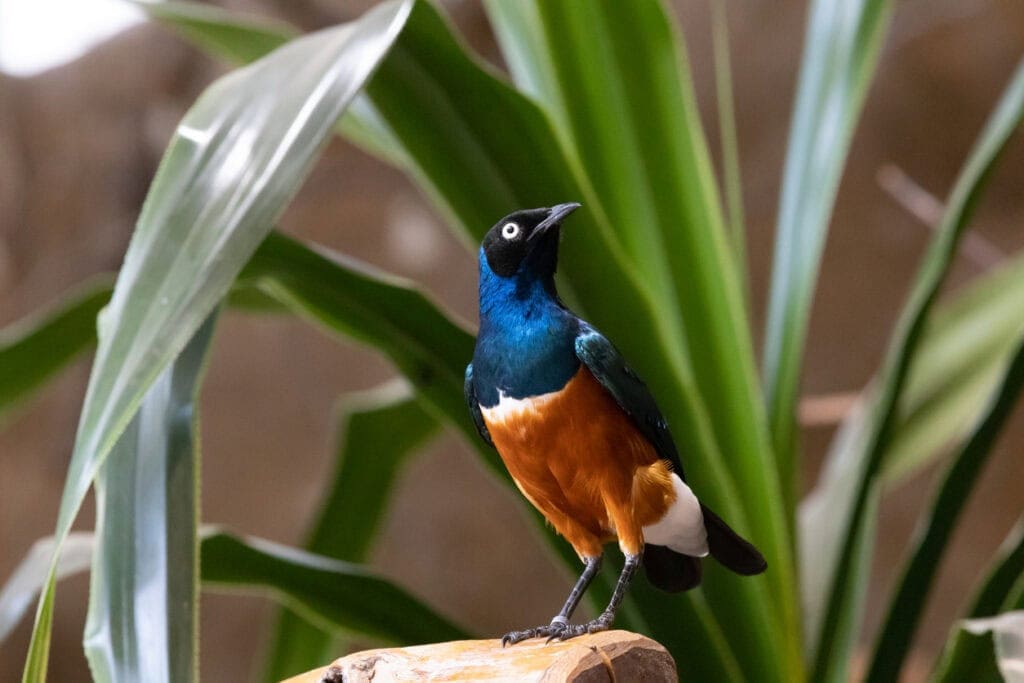
These gregarious birds are often seen in groups, and they’re native to East Africa. They’re found in countries like Kenya, Tanzania, and Ethiopia in stable populations. They inhabit savannahs, grasslands and open woodlands, and their diet consists of insects, seeds and fruits. They generally feed on the ground close to trees. They’re known for their varied and distinctive melodious calls.
4. Grey Crowned Crane (Balearica regulorum)
These elegant and striking birds are also aptly known as the African crowned crane, or the golden crested crane. They’re endangered due to habitat loss and poaching. They’re non-migratory birds that occur from the eastern DRC, Uganda and Kenya to the southeast of South Africa.
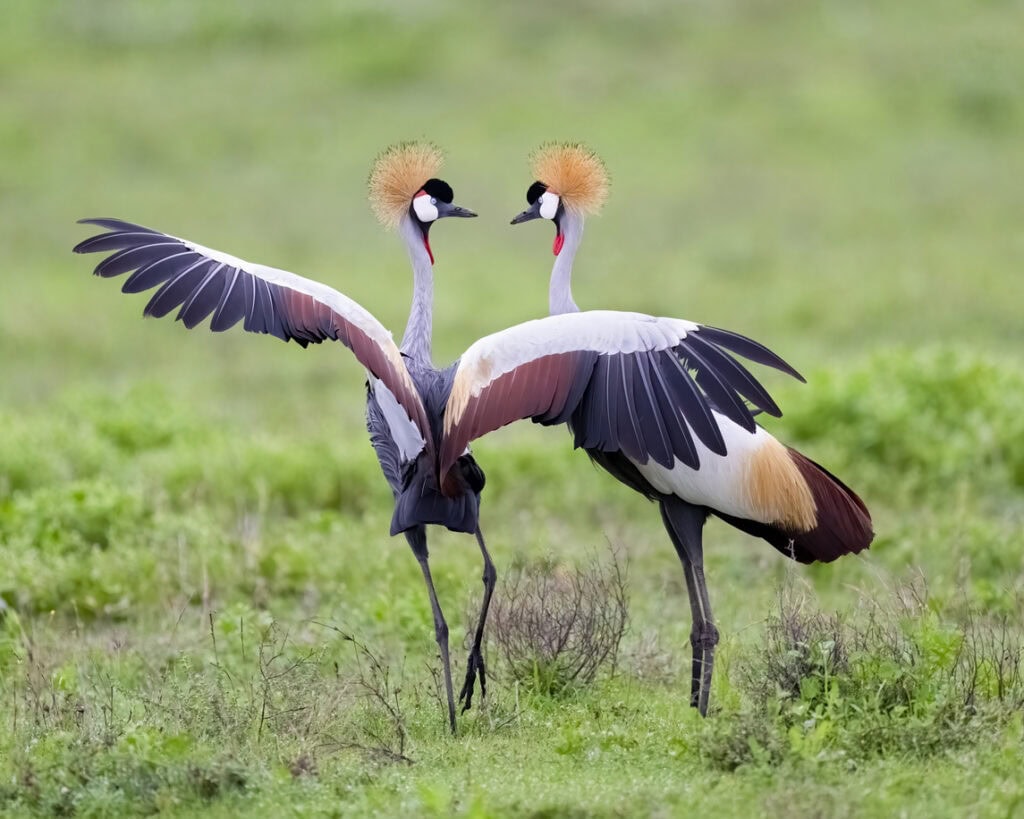
They have impressive wingspans of approximately two metres or 6.5 feet, weigh in at about 3.5 kg or 7,7 lbs, and stand up to 100 cm or more than three feet tall. Grey crowned cranes are renowned for their characteristic crown of upright golden feathers, dramatic black and white faces, and graceful mating dancing displays.
They’re adapted to a range of habitats, including wetlands, grasslands, and cultivated areas. Their diets include insects, snakes, plants, seeds, grain, and even small fish.
5. Saddle-billed Stork (Ephippiorhynchus senegalensis)
Saddle-billed storks are large wading birds found in sub-Saharan Africa. They occur in Sudan, Senegal, Ethiopia, the Gambia, Côte d’Ivoire, Kenya, Chad and South Africa where they’re considered endangered.
They’re known for their dramatic black and white plumage, colourful, saddle-shaped bills and the red and yellow patches on their faces and legs. And they’re large birds! They reach a weight of approximately 6.2 kgs, or close to 14 lbs, and stand 150 cm, or close to 5 ft in height. They have a massive wingspan of up to 2.7 metres which is almost 9 feet!
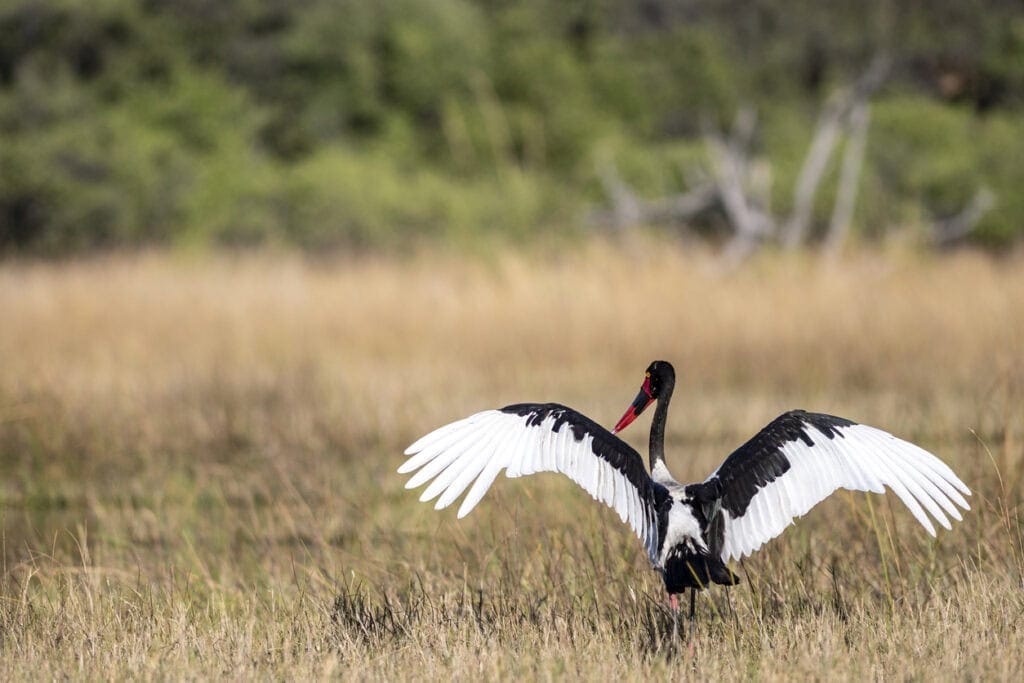
Their habitats include wetlands, marshes, rivers and lakes, and they feed on fish, frogs, molluscs, insects and small reptiles and mammals. They hunt by wading in shallow water and using their long bills to catch their prey. They build massive nesting platforms in trees that they use year after year. They are generally silent except for a distinctive clattering call.
6. Secretary Bird (Sagittarius serpentarius)
The secretary bird In Kenya is a powerful bird of prey primarily found in the open grasslands and savannahs of sub-Saharan Africa. It stands 1.2 m/3.9 ft tall and has a wingspan of more than 2 metres, which is well over 6 ft.
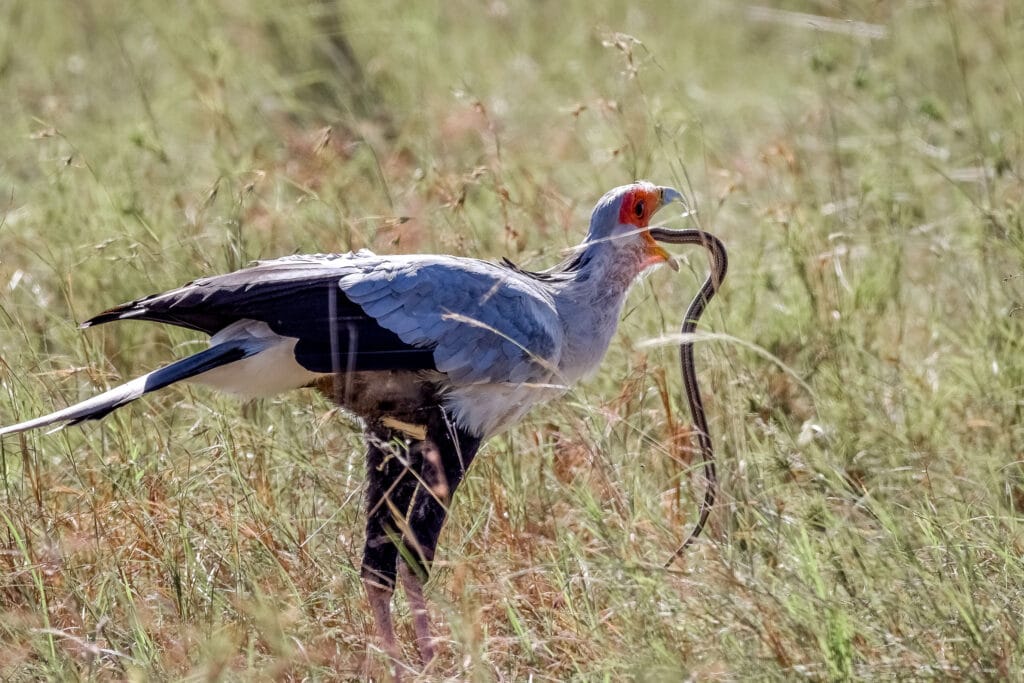
It’s known for its striking appearance, characterised by long, scaly legs, a crest of quill-like feathers on its head, and a striking combination of black, grey, and white plumage. It’s often seen walking in search of prey, which is primarily snakes, but also includes lizards, rodents, grasshoppers, and birds’ eggs.
It typically stomps on its prey to stun or kill it. It plays a vital ecological role in controlling snake and rodent populations. They can be seen in Nairobi National Park, the Masai Mara, and Tsavo West National Park.
7. African Hoopoe (Upupa africana)
The African hoopoe is a resident species found in the DCR, Kenya, Zambia, Zimbabwe, Tanzania, Namibia, Botswana and South Africa. They’re known for their distinctive appearance, featuring a long, thin, curved bill, a prominent crest of feathers on the head, and striking black, white and vivid reddish-brown plumage.
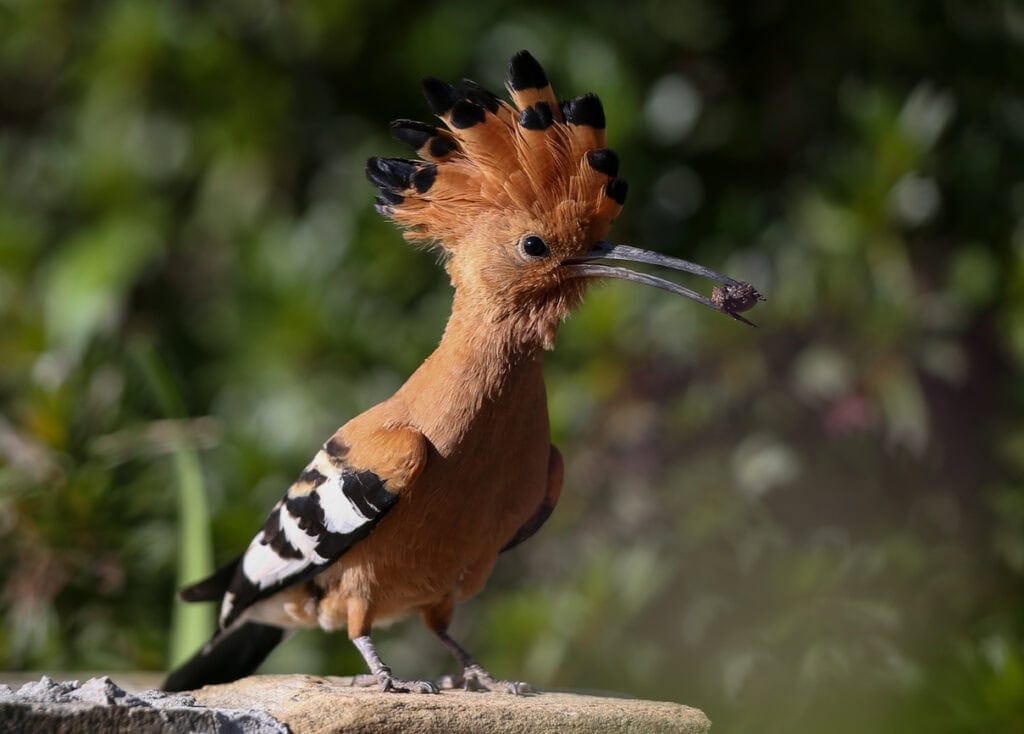
It’s an average-sized bird of about 29 cm or just over 11 inches long. Hoopoes occur in savannahs, woodlands and grasslands, but are often seen foraging in urban gardens as well. It’s primarily insectivorous and feeds on a wide variety of insects like beetles, crickets, locusts, grasshoppers, earwigs, and crickets.
Hoopoes are ecologically significant for controlling insect populations. For the best sightings, head to Amboseli National Park or Maasai Mara National Reserve.
8. Southern Ground Hornbill (Bucorvus leadbeateri)
The southern ground hornbill is the largest of the two species of ground hornbills found exclusively in Africa. It’s classified as vulnerable.
They’re large, striking birds with jet-black plumage, big bills and bright red facial skin and throat wattles. Though they can fly, they’re mostly seen on the ground, rather ponderously foraging for food.
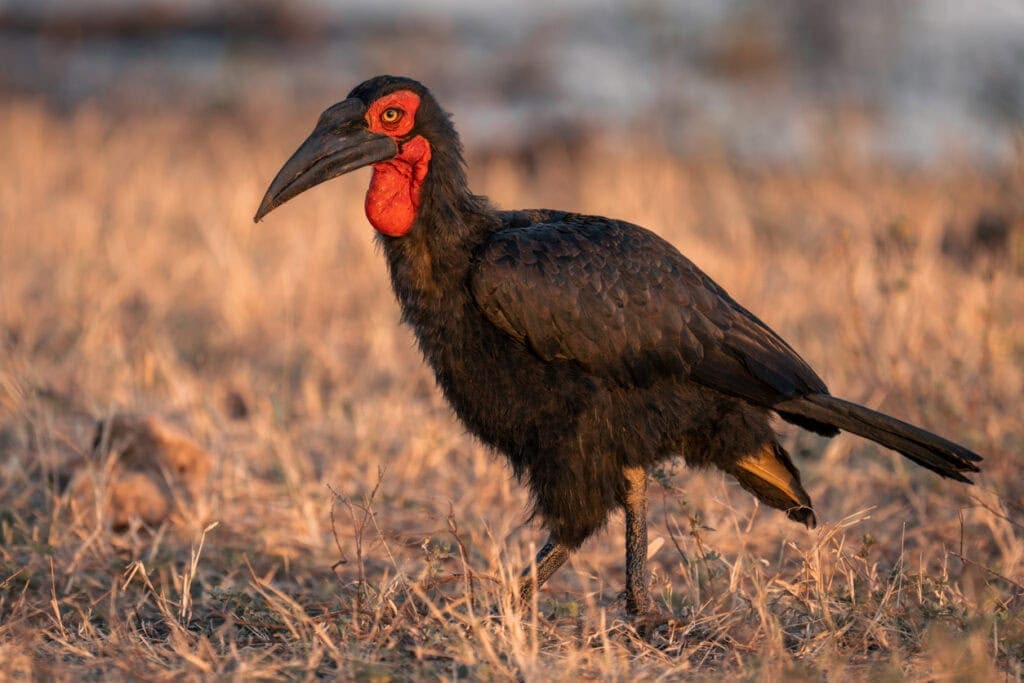
Their diet consists of snakes, frogs, insects, rodents, lizards, bird eggs, nestling birds and insects. They weigh in at about 3.8 ks or more than 8 lbs, and stand about 110 cm in height, which is well over 3 ft tall. They’re known for their deep, booming calls.
9. Yellow-billed Oxpecker (Buphagus africanus)
The yellow-billed oxpecker is native to the savannah regions of sub-Saharan Africa, and occurs in Senegal, Sudan, Kenya, Tanzania, Zimbabwe and South Africa. It’s commonly found in open grasslands, savannahs, and woodland habitats.
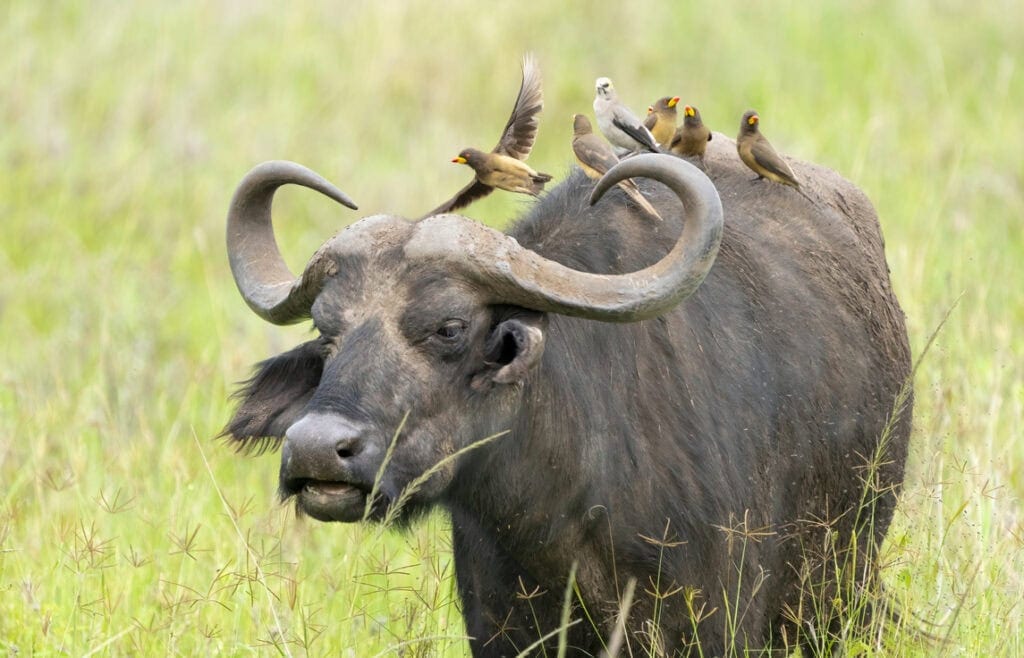
The yellow-billed oxpecker is known for its unique ecological relationship with grazing animals like buffalos, giraffes and various antelopes. It perches on the animals and clambers all over them in order to remove parasites by a sideways action with its beak called ‘scissoring’. This is a mutually beneficial relationship where the bird gets food, and the host animal gets parasites like ticks removed from its coat.
10. African Harrier-Hawk (Polyboroides typus)
The African harrier-hawk, also known as the harrier hawk or gymnogene, is a bird of prey found in most of Africa south of the Sahara. It’s a medium-sized raptor that measures about up to about 66 cm or 26 inches in length and has a mass of just over half a kilogram in weight.
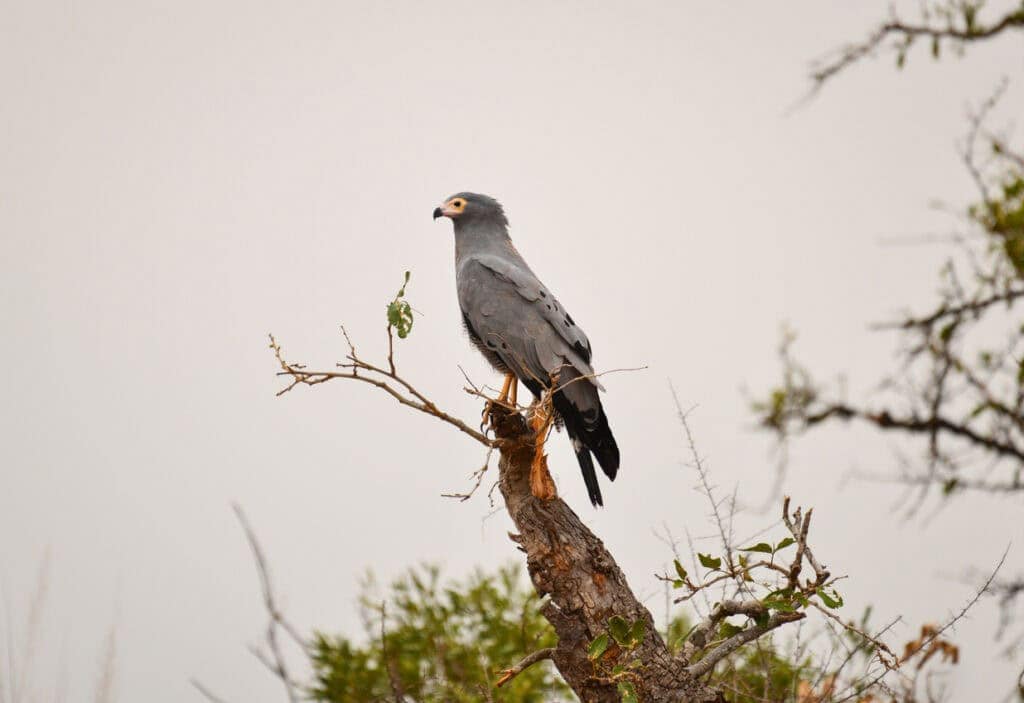
Its upperparts, breast and head are pale grey in colour, while the chest is white with delicate darker barring. It has a distinctive bare red or yellow patch on its face.
These raptors are known for their unique hunting techniques. They can reach deep into crevices and holes for their prey because they have specially adapted intertarsal ‘knee’ joints that can bend both forwards and back. Hence their nickname ‘gymnogene’ – it literally means ‘naked knees’!
Has this whetted your appetite to see Africa’s stunning wildlife and Kenya’s spectacular birdlife in particular? Discover Africa has more than 20 years’ experience in planning safaris. Let us help you plan your next unforgettable Kenyan safari and birding vacation today!
Author: Johnieka Holtzhausen
Published:
Last Update:
Part of the Kenya Safari & Birding Safaris Collections